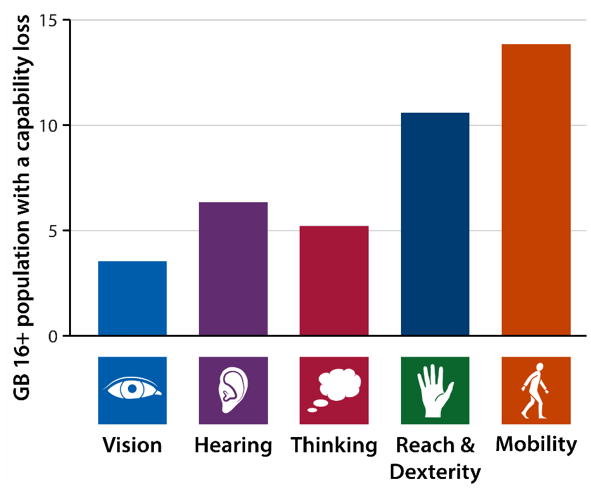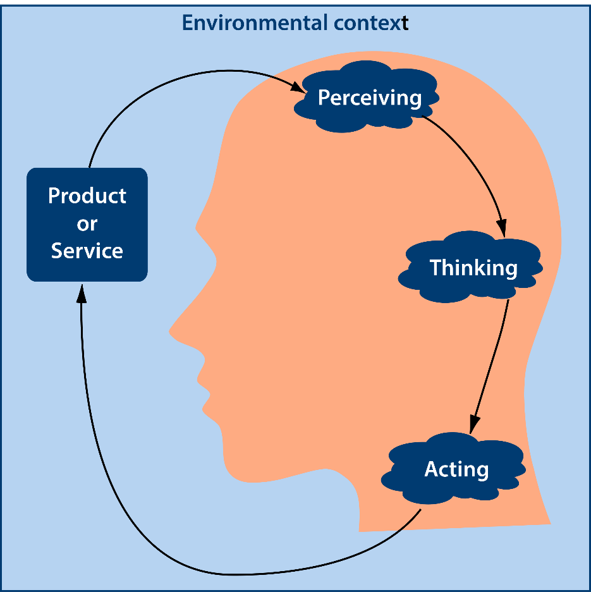Using a product or service makes demands on the user’s capabilities. For example, reading the text on a product requires some Vision ability to see the text and some Thinking ability in order to interpret it. Understanding the range of user capabilities and the impact they have on product use is vital to producing inclusively designed products.
This page explains the different types of user capabilities and how they affect product interaction in general. The next page explains how to use data on capability variation to assess product demand and exclusion. Subsequent pages explore Vision, Hearing, Thinking, Reach and Dexterity and Mobility in more detail. They explain how to produce designs that are more inclusive of people with losses in these capabilities. These pages provide suggestions and highlight issues that need to be considered, but they are not a set of rules to be strictly followed, nor a list of items that can be ‘checked’ to guarantee a successful and inclusive design. The advice works effectively within the context of an inclusive design process, especially in consultation with users and experts, as elaborated within the Process section.
On this page:
Types of user capabilities
User capabilities can be broken down into various categories, of which the following five are particularly relevant for product interaction. All of these should be considered when designing or assessing a product. Click on a category in the list below to find out further information about it.
- Vision is the ability to use the colour and brightness of light to detect objects, discriminate between different surfaces and discern the detail on a surface.
- Hearing is the ability to discriminate specific tones or speech from ambient noise and to tell where sounds are coming from.
- Thinking is the ability to process information, hold attention, store and retrieve memories and select appropriate responses and actions. The ability to understand other people and express oneself to others can also be categorised under thinking.
- Reach and Dexterity concerns the abilities of the arms. It is composed of the ability to reach to different places around the body, perform fine finger manipulation, pick up and carry objects and grasp and squeeze objects.
- Mobility is the ability to move around, climb steps and balance.
User capabilities can be broken down into five main categories that are most relevant for product interaction. Figures refer to the Great British adult population living in private households, derived the 1996/97 Disability Follow-up Survey. See Waller’s 2013 journal paper for details.
A model of product interaction
An interaction with a product or service typically requires a cycle where the user:
- Perceives
- Thinks
- Acts
Perceiving typically involves sensory capabilities like Vision and Hearing. Thinking is also required to process the information received through the senses. Motor capabilities like Reach & Dexterity may also be needed, e.g. to move and orientate the product so that its features can be seen.
Acting typically involves motor capabilities like Reach & Dexterity and Mobility, as well as Thinking to control the action. Sensory capabilities like Vision are also important, e.g. to guide the fingers to press the right buttons.
Thus multiple capabilities are involved in using a product or service, and these are intertwined. It is inadequate to consider an individual capability in isolation. To create effective inclusive design, capabilities need to be considered together.
The interaction between a product and the user’s capabilities is also influenced by the environment in which the product is used. For example, low, or indeed high, ambient light levels can compromise a user’s ability to read.
Feedback
We would welcome your feedback on this page:
Privacy policy. If your feedback comments warrant follow-up communication, we will send you an email using the details you have provided. Feedback comments are anonymized and then stored on our file server. If you select the option to receive or contribute to the news bulletin, we will store your name and email address on our file server for the purposes of managing your subscription. You can unsubscribe and have your details deleted at any time, by using our Unsubscribe form. If you select the option to receive an activation code, we will store your name and email address on our fileserver indefinitely. This information will only be used to contact you for the specific purpose that you have indicated; it will not be shared. We use this personal information with your consent, which you can withdraw at any time.
Read more about how we use your personal data. Any e-mails that are sent or received are stored on our mail server for up to 24 months.




